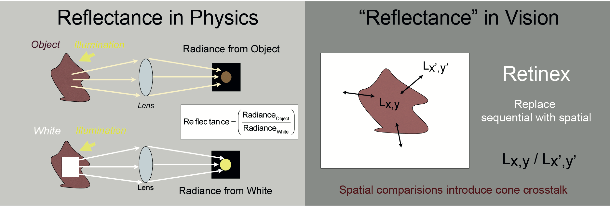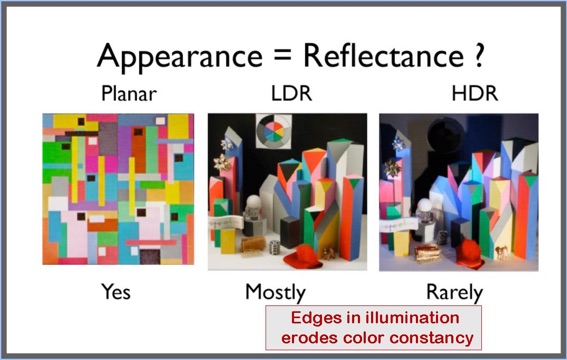Color Constancy

Color Constancy in computer vision is easy to define, and to test. The algorithm must calculate the surface reflectance of the object from the array of scene radiances.
Human color constancy is more complex. Ewald Hering pointed out that constancy is approximate.* The measured deviations from perfect constancy provide important data that let us identify the underlying neural mechanisms.
First, in flat 2-D Planar Mondrians in uniform illumination, the correlation with physical measurements of reflectance is very good, if you use the spectral sensitivity of cones for making these physical measurements. The discrepancies from perfect constancy show that the reflectance is a spatial comparison and is limited by spectral crosstalk between cone sensitivities. (McCann, McKee and Taylor, 1976)
A further study of uniform illumination used a flat display, viewed in 27 different spectral illuminations. The 27 spectra were all possible combinations of three narrow-band (625, 530 and 455 nm) Light Emitting Diodes, using 1, 2 or 4 LEDs. If observers discounted illumination, then the departures from perfect constancy should track the changes in illumination. If spatial comparisons within cone types control constancy, then these departure will be reflectance dependent. The departures will vary with hue and chroma. The data supports the spatial reflectance model, and not the discounting illumination model. Grays are nearly constant, while high-chroma papers vary with cone crosstalk. (McCann, 2004:2005)
2004c CIC12.pdf 05a EI5666 3.pdf Plots of Matches in 27 illuminants
Second, in 3-D Mondrians there are retinal radiance edges from both illumination and reflectances. These experiments used constant reflectance surfaces in Low-Dynamic Range (LDR) and High-Dynamic-Range (HDR) illumination. The LDR illumination was as close to uniform as possible; the HDR used two directional light sources (tungsten and white LED).
We measured the constancy of appearance from identical surfaces. We used both magnitude estimation color matching and Carinna Parraman’s paintings that accurately reproduced the two scenes. LRD illumination showed correlation for most surfaces, but HDR showed correlation with surface reflectance rarely. The edges in illumination act the same as the edges in reflectance in controlling appearance.

____________________________
* In 1872 Hering wrote “The approximate constancy of the colors of seen objects, in spite of large quantitative or qualitative changes of the general illumination of the visual field, is one of the most noteworthy and most important facts in the field of physiological optics. Without this approximate constancy, a piece of chalk on a cloudy day would manifest the same color as a piece of coal does on a sunny day, and in the course of a single day it would have to assume all possible colors that lie between black and white.”
(Hering, E. (1905). Outline of a theory of light sense (L. M. Hurvich and D. Jameson, Trans , Cambridge, Harvard University Press, 1964).
The discrepancies from perfect color constancy are the signature of
the underlying mechanism in humans.

